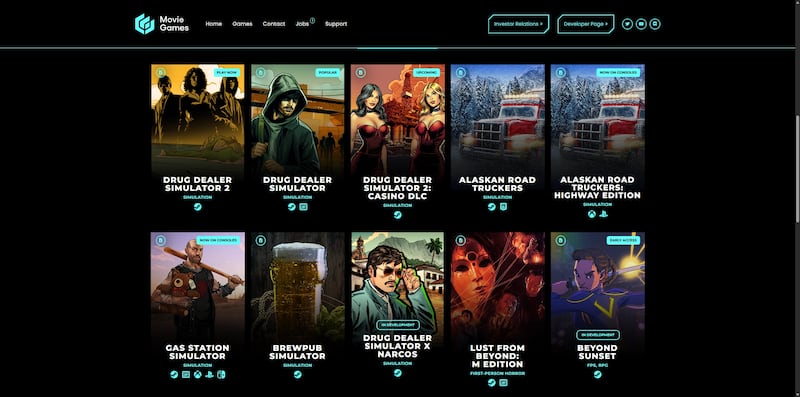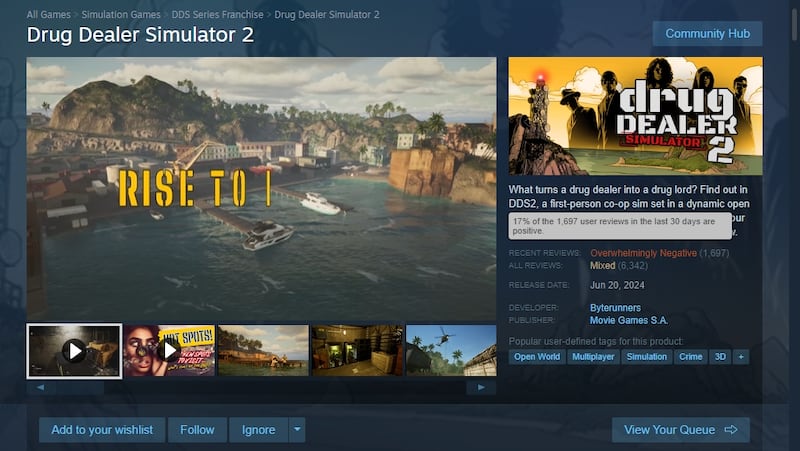In late March 2025, Schedule I quietly launched on Steam. Within a month, the independently developed game had sold more than 3 million copies, generated over $60 million in revenue, and reached a peak of over 450,000 concurrent players with an average of 350,000 players daily.
Created primarily by a solo developer using the alias “Tyler” under the TVGS label, Schedule I quickly rose to the top of Steam’s global charts, outperforming several major titles released around the same time. The game’s controversial subject matter—players assume the role of a fictional criminal building an illicit drug operation—garnered attention, but its appeal stemmed more from structured progression and systems-based design than shock value.

Building an Empire from the Ground Up
Set in the fictional city of Hyland Point, inspired by parts of Oregon, the gameplay followed a gradually expanding loop. Visually, the game employed a low-polygon art style and simple textures, which effectively supported its setting. Dilapidated buildings, neon signage, and cluttered interiors helped establish an atmosphere of informal economies and underground activity.
Players began with limited resources, managing a basic operation from a motel room. As profits grew, the game introduced new production options, expanded properties, and automation systems. The mechanics were framed within a fictional setting, and the developer emphasized that all production processes were intentionally unrealistic and not meant to instruct or promote illegal activity.

Early tasks involved harvesting small cannabis crops and hand-delivering products while evading law enforcement. Over time, complexity increased: players handled customer preferences, expanded distribution, managed personnel, and upgraded production tools.
Players also had to consider risk management. Law enforcement patrols increased as the business expanded, and nighttime activities carried a higher chance of police encounters. Tools such as disguises or weapons could mitigate risks, but often drew attention. Failures, such as missing delivery windows or being caught, had consequences, adding a layer of strategy and tension to each decision.
A Viral Hit
Before launch, “Tyler” expressed doubt about the game’s commercial prospects.. Responding to a fan’s question on Reddit, he wrote, “I’d love to do console ports, but Sony and Microsoft are pretty picky with what they allow on their platforms. If the game does decently well on Steam, I’ll talk to them and see if distributing to PS/Xbox is possible.”
Following its release on March 25, Schedule I gained traction through livestreams and social media. Content creators such as xQc and jacksepticeye showcased the game to millions of viewers, rapidly increasing visibility.
Within a week, Schedule I had not only dominated Steam’s global sales charts but outperformed AAA releases like Tencent and Krafton’s inZOI. Its peak concurrent player count placed it among Steam’s top three most-played games, with a staggering 98% positive rating from over 30,000 user reviews.
Additionally, a free demo version titled Schedule I: Free Sample was downloaded over 500,000 times, helping generate buzz ahead of launch. With regular updates and plans for expanded content—including new maps, substances, and systems—the game is positioned for long-term success.
A Legal Dispute Emerges
As Schedule I climbed the Steam charts and drew widespread attention, it also began to attract scrutiny, most notably from another game publisher with a stake in the same genre.
The game’s success triggered a reaction from Polish publisher Movie Games, known for their Drug Dealer Simulator series—a franchise with similar themes and gameplay. In June of the previous year, the company had released Drug Dealer Simulator 2, continuing their established formula in the simulation-crime space.

On April 6, Movie Games posted a notice in their official Discord server, stating that they had consulted intellectual property experts regarding Schedule I. According to the legal review, they believed there were significant similarities in narrative structure, gameplay mechanics, and UI elements between Schedule I and their own games, suggesting potential infringement.

The statement emphasized that Movie Games had been prompted to take action after receiving repeated community comparisons between the two titles. While they clarified that they were not seeking to have Schedule I removed from sale, they intended to open a formal dialogue with developer TVGS to address the issue.
That said, from the perspective of TVGS, the move appeared unexpected and possibly disingenuous. As reported by PC Gamer, TVGS had previously received a friendly email from Movie Games in March, shortly after the demo launch. The message contained praise for Schedule I and well-wishes for its future;no legal concerns were mentioned at the time. Following that exchange, there was no further communication between the two parties until the public Discord post.
The legal action quickly sparked backlash. After the news spread, users began “review bombing” the Drug Dealer Simulator series on Steam, flooding it with negative ratings. Despite Movie Games stating that no formal lawsuit had been filed and that their development teams were not involved in the dispute, both titles saw their user scores plummet.

As of this writing, TVGS has not issued a formal response. Development updates on Schedule I have continued as planned, and the game’s Discord server has remained quiet on the matter.
Development Philosophy and Community Engagement
Despite being a solo project, Schedule I maintained a robust development pipeline. “Tyler” worked on the game for over three years, with occasional help from friends who contributed graffiti art and music. During Early Access, he maintained a transparent development roadmap and responded rapidly to player feedback.
A Controversial but Commercially Astute Choice
The game’s success raised broader questions about content boundaries and visibility in the indie scene. While the premise invited debate, many players regarded the game as a stylized simulation rather than a realistic portrayal of criminal behavior. Humor and exaggeration in tone helped offset heavier elements, and Valve’s decision to prominently feature the game on Steam signaled commercial merit as the prevailing factor.
The game’s momentum reflected a larger trend in the industry: players continue to support smaller, innovative titles with focused mechanics and original ideas.
Schedule I joined other recent indie successes like Balatro, Lethal Company, and R.E.P.O. in demonstrating that strong design and niche, tightly thought-out experiences could thrive without AAA or big corporate resources.
Its successes hinged on balancing provocative themes with strategic depth, proving that player demand for innovation often outweighs reliance on established formulas. Although Schedule I faced legal scrutiny from an established publisher over alleged similarities, the ongoing dispute did little to slow its momentum. For a game that started in a motel room, its rise suggests that the future of indie games might be just as unpredictable and disruptive as the path that led it to the top.


